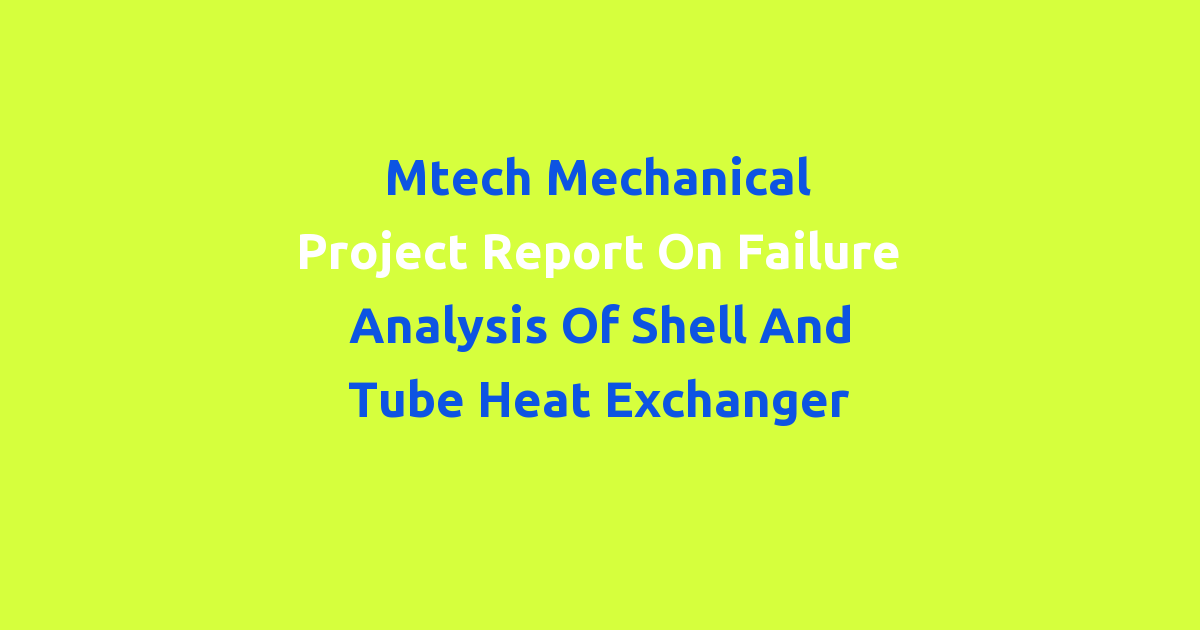Report on failure analysis of shell and tube heat exchanger for MTech mechanical project.
MTech Mechanical Project Report on Failure Analysis of Shell and Tube Heat Exchanger
Introduction
Shell and tube heat exchangers are commonly used in various industrial processes for transferring heat between two fluids. However, these heat exchangers are prone to failures due to various reasons such as fouling, corrosion, vibration, and thermal stress.
The objective of this project is to analyze the failures that occur in shell and tube heat exchangers and propose a new design or solution to mitigate these failures.
Problem Statement
The failure of shell and tube heat exchangers can lead to production downtime, increased maintenance costs, and potential safety hazards. It is essential to identify the root cause of these failures and develop strategies to prevent them.
Existing System
The existing design of shell and tube heat exchangers consists of a cylindrical shell with multiple tubes passing through it. The hot fluid flows through the tubes, while the cold fluid flows around the outside of the tubes in the shell.
However, this design has several disadvantages, including the risk of fouling and corrosion, limited heat transfer efficiency, and potential leakages due to thermal stress.
Disadvantages
One of the major disadvantages of the existing system is fouling, which occurs when deposits build upon the inner surface of the tubes, reducing heat transfer efficiency. This can lead to higher energy consumption and decreased performance of the heat exchanger.
Corrosion is another common issue in shell and tube heat exchangers, particularly in industrial environments where the fluids being processed are corrosive. Corrosion weakens the structure of the heat exchanger, leading to potential leaks and failures.
Additionally, the design of the existing system may not be optimized for heat transfer efficiency, resulting in higher operating costs and lower productivity.
Proposed System
The proposed system aims to address the shortcomings of the existing design by implementing new materials, coatings, or geometries that enhance the performance and longevity of shell and tube heat exchangers.
For example, the use of corrosion-resistant materials like stainless steel or titanium can reduce the risk of corrosion and extend the lifespan of the heat exchanger. Similarly, incorporating anti-fouling coatings on the inner surface of the tubes can prevent fouling and improve heat transfer efficiency.
Furthermore, optimizing the design of the heat exchanger to improve flow distribution, reduce pressure drops, and increase heat transfer rates can result in a more efficient and reliable system.
Advantages
The proposed system offers several advantages over the existing design, including:
- Improved corrosion resistance
- Enhanced heat transfer efficiency
- Reduced maintenance costs
- Increased operating lifespan
By addressing the root causes of failures in shell and tube heat exchangers, the proposed system aims to improve overall system performance and reliability.
Features
The key features of the proposed system include:
- Corrosion-resistant materials for enhanced durability
- Anti-fouling coatings for improved heat transfer efficiency
- Optimized design for better flow distribution and heat transfer rates
- Thermal stress analysis for identifying potential failure points
These features work together to create a robust and reliable shell and tube heat exchanger that can withstand operational challenges and deliver consistent performance over time.
Conclusion
In conclusion, the failure analysis of shell and tube heat exchangers is essential for identifying potential risks and implementing preventive measures to mitigate these risks.
By examining the root causes of failures in the existing system and proposing a new design or solution, this project aims to enhance the performance, reliability, and efficiency of shell and tube heat exchangers in industrial applications.
Through the use of advanced materials, coatings, and design optimizations, the proposed system offers a promising solution to the challenges faced by conventional heat exchangers, paving the way for improved operational outcomes and reduced maintenance costs.
Overall, the findings of this project hold significant implications for the design and operation of shell and tube heat exchangers, contributing to the advancement of heat transfer technology and industrial processes as a whole.

